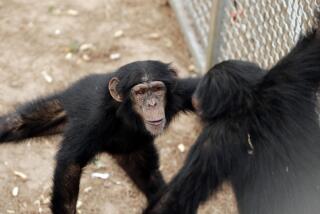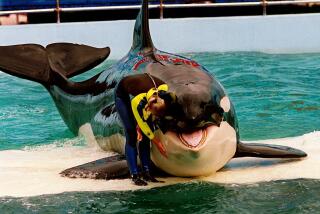Sure, They’re Beasts, but They Feel Your Pain
- Share via
A gorilla named Binti rescues a toddler who falls into her pit at a zoo and is knocked unconscious.
Three dolphins encircle a man wounded by a shark, flapping their fins and tails to ward off the attacker.
A chimpanzee named Washoe leaps over an electrified fence at a research center and pulls another chimp from a water-filled moat.
Scientists have long contemplated the role of empathy in beast and in man. Empathy is the emotional cord that enables one organism to feel another’s pain, to recognize the plight of the sufferer and do something to help.
Not all empathy is equal. There are simple forms (such as flinching when someone else bangs his head) and more sophisticated cognitive forms that include recognizing what has caused pain and devising a way to alleviate it.
But what makes humans or animals act on their empathy?
Evolutionary psychologists claim it is a desire to protect our standing in the gene pool by assisting those most like us. Some scientists say self-interest motivates us, either as expectation that aid will be reciprocated or by the desire to raise our standing in a group. Still other researchers conclude that the only motive we need is our desire to improve the sufferer’s welfare.
The learning of empathy begins soon after birth, says Frans de Waal, a zoologist at Emory University and author of “Good Natured: The Origins of Right and Wrong in Human and Other Animals” (Harvard University Press, 1996). Day-old babies cry when they hear another baby cry, a phenomenon called emotional mood contagion. The same mechanism causes a herd of deer to flee, dogs to howl and birds to take flight at the same time.
At its more advanced levels, empathy requires the ability to distinguish oneself from others, usually determined by whether an animal recognizes itself in a mirror. Chimpanzees, gorillas and orangutans have this skill. Such self-awareness can lead to more empathetic responses through imitation of facial expressions. More advanced expressions of empathetic behavior come later, but their origins lie in the relationship between parents who care for offspring and must be able to respond to their needs. Such empathetic learning, some researchers claim, is then generalized to other affiliations, possibly even across species.
“The thing that enhances empathy is connections, similarities and bonds with others and those who share our genetic makeup,” says Robert Cialdini, a psychology professor at Arizona State University at Tempe who has studied altruism. Such empathizing explains why people feel worse when a few people in their community perish than they do when thousands die in some far-off disaster. “It is also the roots of nepotism and racism. We are not so much trying to ensure our own survival as we are the survival of our own genes.”
Aiding others may also be motivated by a desire to appear prosperous--the theory behind tipping big on the first date, says Cialdini. The extreme version of this is an old tradition among a tribe of Native Americans in the Northwest where the head of the household gives away everything he owns at a wedding or birth, thereby enhancing standing.
But there is clear evidence that empathy followed by helpful behavior is often motivated only by concern for another’s welfare. It is possible that demonstrations of kindheartedness existed in prehistoric man and may be at work in some primates. Fossil remains of a handful of adult Neanderthals and early humans who were physically disabled suggest that our ancestors supported individuals who could not contribute much to the community.
And de Waal documents numerous cases where primates look out for a retarded or deformed member of the troop. (A Japanese monkey born without hands and feet survived a harsh mountainous climate for two decades.) And certainly the motivation of such cross-species altruism as Binti and the dolphins demonstrated does not seem to be a function of gene survival.
What makes one person or one animal in a group more empathetic than others is subject to question. Researchers claim it is a combination of biology, upbringing and the imprinting of cultural mores.
Says Roger Fouts, a primatologist at Central Washington University in Ellensburg: “Gorillas are not only like us, but Binti is extraordinary among gorillas. By her nature, she overcame her incarceration, acting empathetically and it speaks very highly of her. But I am sure there are gorilla thugs out there. Just like there are our Mother Teresas and sociopaths among humans.”






